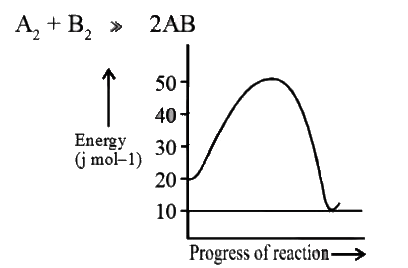Match the column and choose correct option:
(A) MnO−4→Mn+2 (1 mol)P. Required 1 F(B) CuSO4→Cu (1 mol)Q. Required 5 F(C) Al2O3→Al (1 mol)R. Required 3 F(D) NaCl→Na (1 mol)S. Required 2 F
A−Q,B−P,C−S,D−R
A−P,B−Q,C−S,D−R
A−Q,B−S,C−P,D−R
A−Q,B−S,C−R,D−P
The correct Answer is:D
To solve the problem of matching the columns based on the required Faraday's (F) for each reaction, we will analyze each reaction step-by-step.
Step 1: Analyze the reaction of MnO₄⁻ to Mn²⁺
- The half-reaction is: MnO₄⁻ + 8H⁺ + 5e⁻ → Mn²⁺ + 4H₂O
- Here, manganese (Mn) is reduced from +7 oxidation state in MnO₄⁻ to +2 in Mn²⁺.
- This involves the transfer of 5 electrons.
- Since 1 mole of electrons corresponds to 1 Faraday, the total Faraday's required = 5 F.
Step 2: Analyze the reaction of CuSO₄ to Cu
- The half-reaction is: Cu²⁺ + 2e⁻ → Cu
- Copper (Cu) is reduced from +2 oxidation state to 0 in elemental copper.
- This involves the transfer of 2 electrons.
- Therefore, the total Faraday's required = 2 F.
Step 3: Analyze the reaction of Al₂O₃ to Al
- The half-reaction is: Al₂O₃ + 6e⁻ → 2Al
- Aluminum (Al) is reduced from +3 oxidation state in Al₂O₃ to 0 in elemental aluminum.
- This involves the transfer of 6 electrons.
- Therefore, the total Faraday's required = 6 F.
Step 4: Analyze the reaction of NaCl to Na
- The half-reaction is: Na⁺ + e⁻ → Na
- Sodium (Na) is reduced from +1 oxidation state to 0 in elemental sodium.
- This involves the transfer of 1 electron.
- Therefore, the total Faraday's required = 1 F.
Summary of Results
- (A) MnO₄⁻ → Mn²⁺ requires 5 F (matches with Q)
- (B) CuSO₄ → Cu requires 2 F (matches with S)
- (C) Al₂O₃ → Al requires 6 F (matches with R)
- (D) NaCl → Na requires 1 F (matches with P)
Final Matching
- A → Q (5 F)
- B → S (2 F)
- C → R (6 F)
- D → P (1 F)
Correct Option
The correct option that matches the columns is D.
- The half-reaction is: MnO₄⁻ + 8H⁺ + 5e⁻ → Mn²⁺ + 4H₂O
- Here, manganese (Mn) is reduced from +7 oxidation state in MnO₄⁻ to +2 in Mn²⁺.
- This involves the transfer of 5 electrons.
- Since 1 mole of electrons corresponds to 1 Faraday, the total Faraday's required = 5 F.
- The half-reaction is: Cu²⁺ + 2e⁻ → Cu
- Copper (Cu) is reduced from +2 oxidation state to 0 in elemental copper.
- This involves the transfer of 2 electrons.
- Therefore, the total Faraday's required = 2 F.
- The half-reaction is: Al₂O₃ + 6e⁻ → 2Al
- Aluminum (Al) is reduced from +3 oxidation state in Al₂O₃ to 0 in elemental aluminum.
- This involves the transfer of 6 electrons.
- Therefore, the total Faraday's required = 6 F.
- The half-reaction is: Na⁺ + e⁻ → Na
- Sodium (Na) is reduced from +1 oxidation state to 0 in elemental sodium.
- This involves the transfer of 1 electron.
- Therefore, the total Faraday's required = 1 F.
- (A) MnO₄⁻ → Mn²⁺ requires 5 F (matches with Q)
- (B) CuSO₄ → Cu requires 2 F (matches with S)
- (C) Al₂O₃ → Al requires 6 F (matches with R)
- (D) NaCl → Na requires 1 F (matches with P)
- A → Q (5 F)
- B → S (2 F)
- C → R (6 F)
- D → P (1 F)
The correct option that matches the columns is D.
Topper's Solved these Questions
- ELECTROCHEMISTRY BOOK - CBSE COMPLEMENTARY MATERIALCHAPTER - ELECTROCHEMISTRY EXERCISE - Assertion-Reason type
2 Videos
- ELECTROCHEMISTRY BOOK - CBSE COMPLEMENTARY MATERIALCHAPTER - ELECTROCHEMISTRY EXERCISE - VERY SHORT ANSWER TYPE QUESTIONS (1 Mark)
20 Videos
- ELECTROCHEMISTRY BOOK - CBSE COMPLEMENTARY MATERIALCHAPTER - ELECTROCHEMISTRY EXERCISE - LONG ANSWER TYPE QUESTIONS (5 Marks)
7 Videos
- COORDINATION COMPOUNDSBOOK - CBSE COMPLEMENTARY MATERIALCHAPTER - COORDINATION COMPOUNDSEXERCISE - LONG ANSWER TYPE QUESTIONS
3 Videos
- GENERAL PRINCIPLES AND PROCESSES OF ISOLATION OF ELEMENTSBOOK - CBSE COMPLEMENTARY MATERIALCHAPTER - GENERAL PRINCIPLES AND PROCESSES OF ISOLATION OF ELEMENTSEXERCISE - Short Answer-II Type Questions
5 Videos
Similar Questions
Knowledge Check
The charge required for the reduction of 1 mol of MnO−4 to MnO2 is
A1FB3FC5FD6FHow many faradays are required to reduce 1 mol of MnO−4 to Mn2+?
A1B2C3D5For decolourisation of 1mol ofKMnO4, the moles of H2O2 required is
A1/2B3/2C5/2D7/2
Consider the following energy diagram for the reaction.
A2+B2?2AB

Column IColumn II(A)Ea(f)(P)−10 kJ mol−1(B)Ea(b)(Q)40 kJ mol−1(C)ΔHr(R)30 kJ mol−1(D)ET(S)50 kJ mol−1
View SolutionHow many moles of electrons are required to
(i) reduce 1 mol of MnO−4 to Mn2+
(ii) produce 10.0 g of Al from molten Al2O3 ?
View SolutionThe charge required for the reduction of 1 mol of MnO−4 to MnO2 is
View SolutionHow many coulombs are required for the oxidation of 1 mol of H2O2 ?
View SolutionThe charge required for the reduction of 1mol Cr2O2−7 ions to Cr3+ is
View Solution
